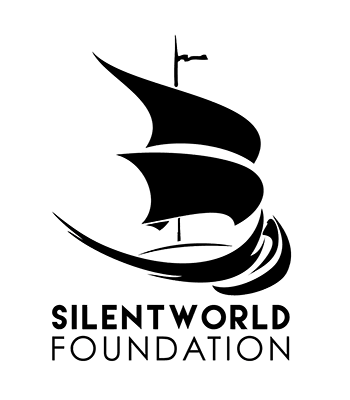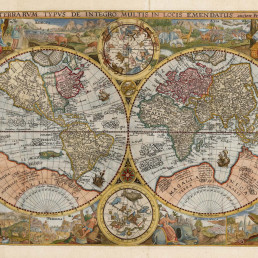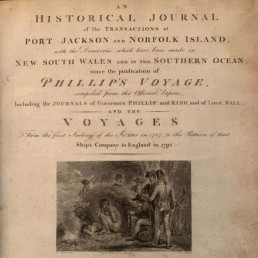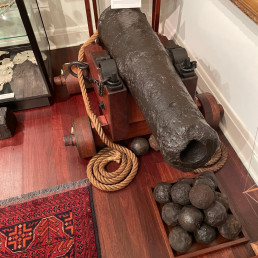
Name/TitleThe merchantman MEDINA OF LONDON
About this objectThis painting was probably commissioned to celebrate MEDINA‘s completion and maiden voyage. In 1830, MEDINA carried goods and emigrants to the newly founded Swan River Colony in Western Australia.
Whitcombe was an expert portraitist of ships, employing even lighting and very fine brushwork to convey every detail of structure and rigging. The name 'Medina of London' is carved across the stern in the right-hand view of the vessel. In the background, the white cliffs of Dover gleam in the sun: a poignant symbol of England for shipping departing for, or arriving from, long and hazardous voyages.
A full-rigged merchantman of 469 tons, MEDINA was built at Topsham, Devon in 1811 and owned by Davy & Co. of London who put her into the Jamaica trade under the command of Captain Kenneday. In 1820-21 she was sold to Haymans and made voyages to Bombay under her new master, Captain Hayley. She then transferred to the London-New South Wales route.
In 1830, MEDINA carried goods and emigrants to the newly-founded Swan River Colony in Western Australia. Intended as a 'free' colony for farmers rather than a penal colony like Sydney, the Swan River Colony was claimed for Britain by Captain Charles Fremantle of HMS CHALLENGER on 2nd May 1829. The towns of Perth and Fremantle were named in August. MEDINA, commanded by Captain Walter Pace, arrived in Fremantle on 16th July 1830.
In 1832 Pace settled in Western Australia and a suburb of Kwinana on the Swan River was later named in MEDINA's honour. MEDINA's many long voyages took their toll and by 1834 she was laid up in the Port of London, where she was sold for £9,500.
Thomas Whitcombe painted major naval battles from the American War of Independence to the Napoleonic Wars, recording the battle of the Saintes, Camperdown and the Nile, among others. He was skilled at painting the majestic and deadly array of ships drawn up in battle line.
Little is known of Thomas Whitcombe's life, despite his eminence as a marine painter. His output was large, and he contributed greatly to recording the naval side of the French Revolutionary wars. He produced watercolours for fifty-four plates of The Naval Achievements of Great Britain, published in 1817, and made paintings for at least one hundred more wartime engravings, as well as depicting peaceful subjects such as coastal scenes.
Whitcombe exhibited one painting at the British Institution, in 1820. He exhibited at the Royal Academy from 1783 to 1824, working from London addresses.
MakerThomas Whitcombe - Artist
Maker RoleArtist
Date Made1820
Period19th century
Medium and MaterialsOil on canvas
Place MadeUnited Kingdom
Place MadeSwan River, Western Australia
Measurements295mm x 240 mm
Object TypeMaritime Paintings
Object numberSF001391
Copyright Licence![]() Attribution - Non-commercial - No Derivatives (cc)
Attribution - Non-commercial - No Derivatives (cc)
Explore by category
Maps and Charts
Date range: 1541-1836
Ship Models
Date range: 1629-1890
Maritime Paintings
Date range: 1793-1849
Manuscripts and Ephemera
Date range: 1768-c1850
Medallions & Convict Tokens
Date range: 1619-1880
Landscapes
Date range: 1768-c1850
Books
Date range: 1694-c1850
Currency and Shares
Date range: 1624-1823
Printed Material
Date range: 1541-1836
Maritime Archaeology
Date range: 1629-1854
Curator's corner
New acquisitions, staff favourites and curios
The mug is decorated with an underglaze and a blue transfer print. On the body, it is titled ‘Emigrants to Australia’. This type of body and glaze was discontinued by 1840. Comparison of the handle shape and the profile of the foot, point to the attribution of manufacture by the Davenport Factory.
Delta was a ship-rigged vessel with two decks and three masts. It was built in Dordrecht, Netherlands in 1839 at the shipyard of Jan Schouten and registered in the same port. Its hull was constructed of oak and sheathed in ‘yellow metal’. Delta was owned by H. van der Sande at the time of its loss and was engaged as a cargo trader.
The Delta carried 29 crew and passengers, while sailing from Melbourne to Batavia in ballast when wrecked at Kenn Reefs on 30 May 1854 whilst under the command of Captain J.G. Kunst. This vessel loss supports the pattern of shipwrecks located on a well-travelled shipping route that was poorly charted until the mid-nineteenth century. The crew of the Delta could see four other shipwrecks at Kenn Reefs at the time of their vessel’s loss.
Important image of a ship associated with Matthew Flinders, that would shortly become one of the most famous early shipwrecks in eastern Australian waters. This is a fine ship’s portrait, by one of the great exponents of the art


















